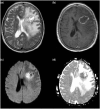Advanced magnetic resonance imaging biomarkers of cerebral metastases
- PMID: 22935843
- PMCID: PMC3458786
- DOI: 10.1102/1470-7330.2012.0012
Advanced magnetic resonance imaging biomarkers of cerebral metastases
Abstract
There are a number of magnetic resonance imaging techniques available for use in the diagnosis and management of patients with cerebral metastases. This article reviews these techniques, in particular, the advanced imaging methodologies from which quantitative parameters can be derived, the role of these imaging biomarkers have in distinguishing metastases from primary central nervous system tumours and tumour mimics, and metrics that may be of value in predicting the origin of the primary tumour.
Figures




References
-
- Posner JB, Chernik NL. Intracranial metastases from systemic cancer. Adv Neurol. 1978;19:579–92. - PubMed
Publication types
MeSH terms
Substances
LinkOut - more resources
Full Text Sources
Medical
